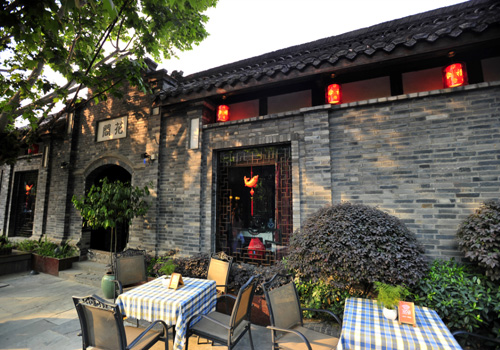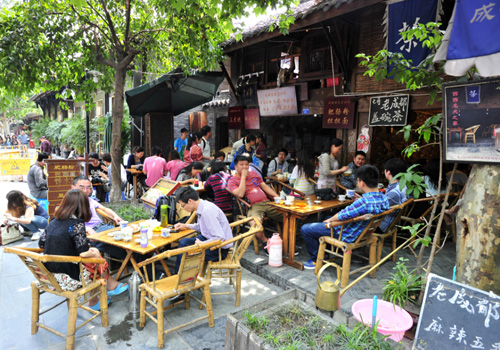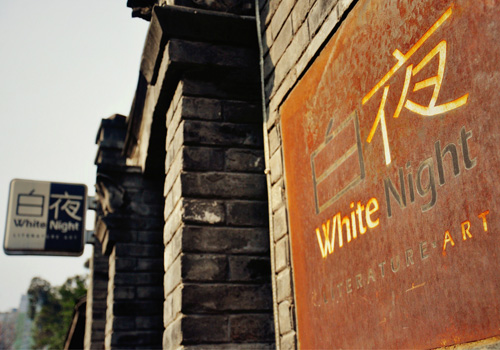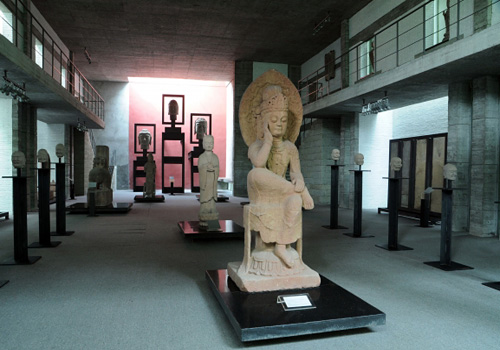Chengdu, a city of the common kind but with great grace
2014-03-20China travel Guide
In China, at the mere mention of Chengdu, people habitually use the word leisure, a word accurately summarize Chengdu’s peculiarity - a city in common people’s style but with an attribute grace.
Kuan Alley, strong smack of everyday life

It is said that Chengdu is one of the few cities not changed in the history, even its name and townsite are still the same as it were thousands of years ago. However, Chengdu is with no exception as other cities maintain few old architecture but find Kuan Alley, and its adjoining Zhai Alley and Jing Alley, which preserves unadorned old dwellings though luxury residences were abandoned. Located in the central area, Kuan Alley is a collection of teahouses, inns and restaurants of the most Chengdu style with strong smack of everyday life. It shows the city’s most common trivial but happy life since the ancient times to this day. For local Chengdu, Kuan Alley is an icon, they enjoy the kind slow life style, the composture and leisure, which are clearly reflected in their afternoon tea there in a blue-and-white tea cup.
Teahouses crazily spread all over the city
In Chengdu, the chances to meet an acquaintance always happen in a teahouse. Yes it proves how much Chengdu people love tea, no wonder the city has the most teahouses than any other China cities.

Chengdu people use teahouse as a living room, they date with their friends and business partners in a teahouse; they use teahouse as working place as well, they take their laptops there as people do in cafes in other cities. Teahouses emerges in the works of any literati from Chengdu in all ages. The widespread teahouses deeply imprint on local’s life and silently influence their personality: talkative, humour, genial, sensible and optimistic. For Chengdu people, it is the life that have a tea sitting on bamboo chair around a stone table, under a grape trellis or a fragrant cassia tree in a delicate teahouse. Tea are usually scented tea, teacups are the same in the appearance as the used hundreds of years ago, time seems to cease here.
Intellectuals are humbled by flavors, open their own restaurants

Sichuan people favor spicy and good flavors since ancient times which is tested in the book Chronicles of Huayang wrote about 1600 years ago. Compare with other Chinese cuisines, the most famous Sichuan Cuisine is the most grass-rooted using most ordinary raw materials, but has the closest relationship with intellectuals. Ancient Sichuan scholars wrote books regards to dishes, yet modern Chengdu literati open their own restaurants, for instance, Li Jiliren, a modern writer, a gastronome for Sichuan Cuisine and a shrewed restaurant (Xiao Ya) operator; Li Yawei, a contemporary poet, a boss of a culture company, gives up all the titles in the end except an exclusive boss of his antique-decorated restaurant Xiang Ji Chu. Almost without exception, all such restaurants are exquisite designed, sells common Sichuan dishes, often patronized by celebrities of the circles. Other well known restaurants include poet Yang Lu’s Muxing No.16, poet Zhai Yong-Ming’s bar White Night, poet Shi Guang-Hua’s Shang Xi...Those literati’s restaurants offer eating places and simultaneously a special emotional appeal in this commercial age.
Art colonies lurk among the civilian

As for Chengdu, a city replete with strong smack of everyday life, is not graceful if not rendered by art. Luye Garden, with a poetic Chinese name, a museum set off among bamboos and forest on river bank in the suburb of Chengdu, displays over 1000 ancient stone art pieces and Buddhism carvings. The resort hotel of the same name is separated from it only by a wall. The designer of the garden is Liu Jia-Kun, an actor, author and architect, famous for its odd design. Apart from this garden, his proudest work, Liu also designed couples of studios for famous painters in Sichuan, including the respected Ye Yu-Shan’s. His studio and exhibition hall is built on Muma Hill with a courtyard, which attracts hundreds of egrets finding food everyday, and this old artists spend nearly 100 000 RMB each year to buy loaches to feed those lively egrets. Luye Garden, painters village, art institutes and literature institutes, though never enter into the art mainstream, those art colonies lurk in the folk is a voiceless existence that can not be ignored and add special appeals to this leisure city Chengdu.
--- By April (VisitOurChina)




